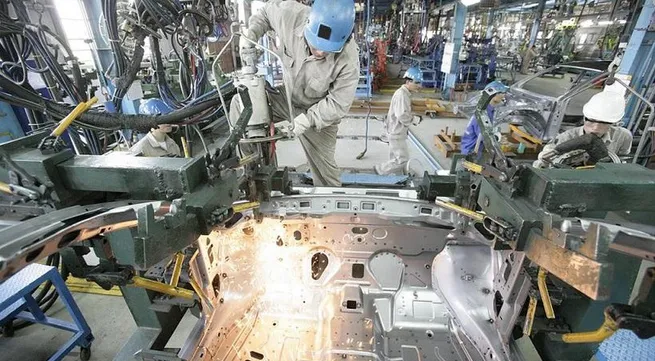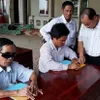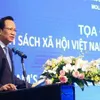Sturdy solutions necessitated to achieve 2023 goals

At a governmental meeting on December 6 on fiscal and monetary policies and the macro-economic situation for the end of 2022 and the beginning of 2023, Prime Minister Pham Minh Chinh stated that in the coming time, though there will be opportunities for the domestic economy to go forward, massive challenges and risks will also appear.
“However, challenges will be bigger opportunities and advantages,” PM Chinh stressed. “We must do our best to overcome difficulties so that the country can fulfill all targets set out in the Plan on Socio-economic Development for 2023 (PSED).”
“We have made strong determination, such determination must be stronger. We have made great efforts, but the efforts must be greater,” PM Chinh said. “We cannot be satisfied with what we have achieved, and must have more effective and timely policies to support the economy.”
Especially he ordered the Ministry of Planning and Investment to formulate more solutions to strengthen the confidence of people, enterprises, and investors, and to boost the implementation of the national 15-billion-USD Socio-economic Development and Recovery Programme (SDRP) which remains slow now – affecting the government’s efforts to support enterprises and people and the economy’s competitiveness.
This is quite important especially amid the economy’s gradual recovery which is in critical need of great momentum in order to take off more quickly and reduce ongoing challenges and risks.
New landscape
The National Assembly (NA) last month passed a resolution on the country’s PSED which had been under intensive discussions by lawmakers based on the existing situation and predictions of internal and external developments, especially global geopolitical tensions that may undermine the country’s efforts to achieve its desired targets.
Under the PSED, the GDP growth is set to be 6.5% – which is lower than this year’s expected 8%, while per capita income will be 4,400 USD – higher than this year’s expected 4,075 USD, and the ratio of the manufacturing and processing industry in GDP will be 25.4-25.8% – the same as this year’s 25.8%.
According to a governmental report recently sent to the National Assembly Standing Committee, although the growth goal of 6.5% for 2023 has been set, it may be impacted by many types of risks currently seen in the economy and in the global economy.
“Disadvantages that can negatively influence the Vietnamese economic growth in 2023 are very big, with many difficulties and challenges which happen in a rapid, unexpected, and complicate manner. They will have comprehensive negative impacts on the entire economy, especially fluctuations in prices of fuel and input materials – and this will cause great pressure to local production and inflation, with expected hikes in production costs,” said the report. “What is more, there will continue to be numerous risks in supply chains with a drop in demands from Vietnam’s traditional and large export markets. This will also make it difficult for the government to formulate accurate policy predictions.”
The government also admitted that the risks will become bigger as the domestic economy is quite open to global economy, meaning its export-import turnover has nearly doubled its GDP.
According to the General Statistics Office, Vietnam’s total export-import value in 2021 was 668.54 billion USD, which was 1.81 times higher than GDP of 368.68 billion USD. The total export-import revenue reached 336.31 billion USD and 332.23 billion USD, up 19 and 26.5% year-on-year, respectively.
“With unpredictable risks and uncertainties, it is projected that the Vietnamese economy will continue facing many difficulties and challenges in the coming time,” said Minister of Planning and Investment Nguyen Chi Dung.
According to the Asian Development Bank (ADB), Vietnam’s economic prospects continue to face heightened risks.
“Risks to Vietnam’s economic outlook remain elevated. The global economic slowdown could weigh more heavily on exports than forecast, which would worsen the current account balance. Although aggressive interest hikes by the central banks of major economies have helped dampen global price pressures, an intensification of global geopolitical uncertainties could push up commodity prices, worsening inflation in Vietnam,” said the ADB in a recent report on the Vietnamese economic situation. “A labour shortage would impede the fast recovery of services and the labour-intensive export sector in 2022.”
Boosting the PSRD implementation
The bank also noted the slow delivery of planned public investment and social spending, especially the implementation of PSRD, could slow growth this year and the next.
The government and the legislature have demonstrated their qualm that it has been more than 11 months since the 2022-2023 PRSD was enacted with a support package worth 15 billion USD, a large part of work for this year has yet to be done.
Statistics from the government showed that in public investment disbursement and implementation of the PSRD and three national target programmes on new rural development, socioeconomic development in ethnic minorities and mountainous areas, and poverty reduction, it is estimated that the disbursement of state capital until November stood at 297.8 trillion VND (12.95 billion USD) - or 51.34% - out of the total 580 trillion VND (25.21 billion USD) assigned by the prime minister. This rose by 15.7% as compared to the corresponding period last year, with a number of initial results harvested.
Nevertheless, the planned capital that must be disbursed until the year’s end is very big, at nearly 282 trillion VND (12.26 billion USD), of which 30.5% is for ministries and central agencies, and 69.5% is for localities. As much as 8% of the PSRD’s total capital for 2022 has yet to be allocated, and the deployment of a number of policies including a 2% lending rate support scheme remains at a snail’s pace.
“All national target programmes, and duties to carry out the fiscal and monetary policy to serve the PSRD are being implemented in a slow manner, with some important policies currently being in the stage of drafting guidance,” said Vu Hong Thanh, Chairman of the National Assembly Economic Committee.
According to this committee, the disbursement of the infrastructure development package has also been slow – specifically it was not until the end of August that the government submitted to the National Assembly Standing Committee a report on investment portfolio and capital quotas for projects and duties carved in the PSRD.
The PSRD, also the first of its kind in Vietnam, came amid businesses and people suffering from massive woes caused by COVID-19. It is expected to facilitate the domestic economy to reach an economic growth rate of at 6.5-7% in the period of 2021-2025.
The PSRD embraces five major packages, including re-opening the economy associated with promoting medical capacity, and pandemic prevention and control (2.6 billion USD); ensuring social welfare and employment (2.31 billion USD); supporting the recovery of businesses, cooperatives and business households (4.78 billion USD); infrastructure development (4.95 billion USD); raising institutional and administrative reform, and bettering the investment and business climate. What is more, another 434.8 million USD will be mobilised from non-state budget financial funds.
Under the PSRD, VAT for applicable goods and services has been reduced to 8%, excluding that for goods and services in the industries of telecommunications, IT, finance and banking, insurance, securities, property, metal production and mining industries (except coal), coke production, petroleum, chemicals, and commodities and services which are subject to special consumption tax.
“We must continue focusing on creating all the best conditions for enterprises to boost production and business activities, diversify products, markets, supply chains, and technological renovation, and expand promotion of investment, trade, and tourism as well,” stated Prime Minister Chinh.
“We will continue maintaining socio-political and macro-economic stability; removing bottlenecks of the economy in terms of legal institutions, infrastructure and human resources; developing supply chains; decreasing transaction costs, especially logistic and administrative costs; building a stable environment and policies; and exercising transparency and accountability,” he said.
Tags:





